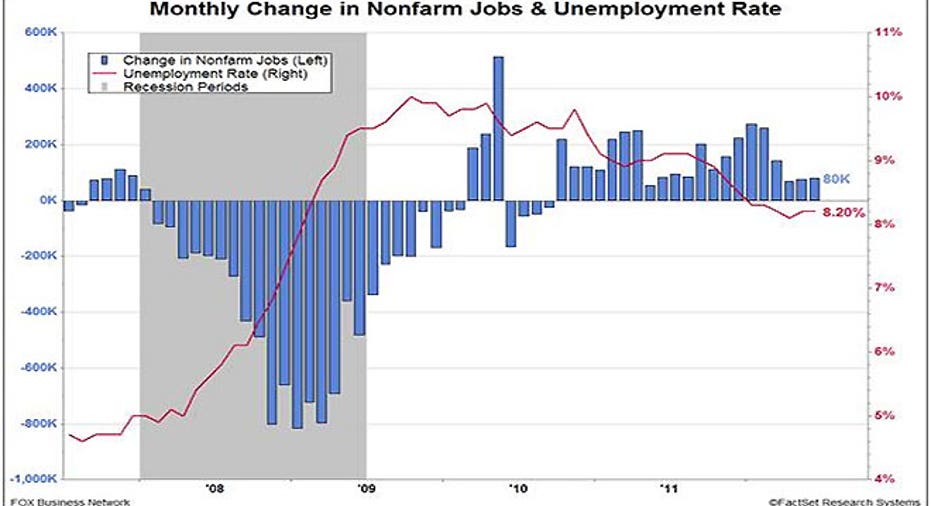June Jobs Report Deepens Economic Gloom

U.S. employers added a paltry 80,000 jobs in June, capping off an abysmal quarter of employment growth and raising the pressure on the Federal Reserve to once again stave off a double-dip recession.
Hopes that the two-month slump in payroll growth would prove to be a weather-fueled anomaly were shattered by Friday’s report, which sent the Dow Jones Industrial Average careening nearly 200 points into the red and ate into President Obama's political fortunes.
While there were a few silver linings in the data, the overall report cemented concerns that the U.S. is again suffering a slowdown that could morph into something more serious.
“Here we are about three years into this so-called recovery and the recent data are more consistent with late cycle developments,” RBC Capital chief U.S. economist Tom Porcelli wrote in a note, pointing to alarming trends like peaking aggregate hours. “In other words, trends typically exhibited leading into a recession.”
Hiring Slowdown Persists
The U.S. has now added an average of just 75,000 jobs a month over the past three months, a 67% plunge from the prior three-month average of a healthy 226,000 jobs.
“Let’s just agree; this number stinks. Job growth of less than 100K for the third consecutive month just stinks,” Dan Greenhaus, chief global strategist at BTIG, wrote in a note.
There were also some scary metrics beyond the headline disappointment.
The U-6 rate, which is a broader measure of employment that includes those who have given up looking for a job or who consider themselves underemployed, ticked up to 14.9% from 14.8%. The number of Americans working part time for economic reasons also leaped by 112,000 last month.
There are a slew of reasons to explain the recent slowdown in hiring, including the intensifying European debt mess, the looming fiscal cliff in the U.S., seasonal factors and payback for the unseasonably warm winter weather.
“We continue to believe that higher uncertainty from events in Europe and, to a lesser degree, the potential for significant fiscal tightening in the U.S. early next year are causing firms to postpone investment and hiring decisions,” wrote Michael Gapen, director of U.S. economic research at Barclays (NYSE:BCS).
Silver Linings
However, economists did glean a few encouraging data points from the June jobs report, including a stronger-than-expected 0.3% increase in average hourly earnings and average working hours inching up to 34.5 from 34.4.
Likewise, the aggregate weekly payroll index ticked up by 0.7% from May. Also, the construction industry added 2,000 jobs, breaking a four-month slump and suggesting the weather payback may have finally trickled through the system.
Temporary jobs also jumped by 25,000 in June, marking the third-straight increase for that metric. Gapen noted that “temporary help is often a good gauge for future hiring intentions.”
It’s also worth pointing out that ADP’s private-sector employment report on Thursday showed the U.S. added 176,000 private-sector jobs in June, besting forecasts for a rise of just 105,000.
Your Move, Ben
Despite these bright spots, the June jobs report has added to investors’ recent economic headaches, including a report earlier this week that revealed the first contraction in the U.S. manufacturing sector since July 2009.
All of this shifts the attention back to the Fed, which has time and again unveiled easy-money policies aimed at boosting the economy and juicing risk assets like stocks.
Economists seem to believe the June jobs report increases the odds of more intervention, likely in the form a third quantitative easing program, but they caution the deal hasn’t been sealed just yet. The central bank’s policy arm next meets at the end of July, yet Fed watchers are paying more attention to the mid-September meeting when an additional pair of jobs reports will be available.
“A sub-100,000 pace of payrolls…might be enough to deliver another round of QE” if it continues for the next two months, Bruce Kasman, chief economist at J.P. Morgan Chase (NYSE:JPM), said on a conference call Friday morning. “We think it’s a pretty close call.”
Last month Ben Bernanke and the Fed opted for a middle ground, choosing to extend its Operation Twist program instead of launching QE3.
Porcelli said he believes the disappointing June jobs report “solidifies for” Bernanke that “the slowing is real.” He added, “We think this backdrop is primed to bring about a third round of asset purchases.”
“We find it hard to believe that the Federal Reserve, whatever the cause of the slowdown, will stand idly by as a generation of workers see their lifetime earnings potential eroded by unemployment, underemployment and/or stagnant wages,” Greenhaus wrote.
Political Implications Eyed
The unemployment problem is also likely to weigh on Obama’s political fortunes just four months out from the election.
While Obama acknowledged on Friday “it’s still tough out there,” his opponents used the latest jobs report to criticize the administration’s economic strategy.
“The president's policies have not gotten America working again and the president is going to have to stand up and take responsibility for it,” GOP presidential candidate Mitt Romney said on Friday.
Obama’s re-election odds took a hit on Friday on InTrade, the exchange that allows investors to bet on political outcomes. InTrade now pegs Obama’s re-election chances at 55.2%, down from 56.3% on Thursday and north of 60% in late April.



















